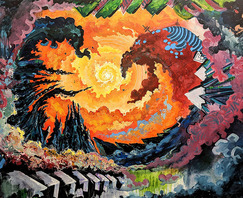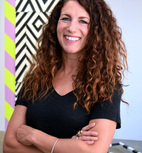
Academics . Painting . Courses
Painting Courses
Professional Practices: Entrepreneurial Ventures
Course No. PPEL 398A Credits: 3.0
This course provides an overview of the environment surrounding the business of art and design, and the practice of the individual. One of the two class meeting per week is a core lecture series that covers self-promotion, networking, ethics, intellectual property, contracts, professional development, and guidance by practicing professionals. During the other weekly meeting, students attend a breakout session for the specific course in which they are enrolled. The breakout session for this course, Professional Practices: Entrepreneurial Ventures, transports the student through the key decisions required to establish a successful art/design business. 3 credits.
Pro Pract: Entrepreneurial Ventures
Course No. PPEL 398A Credits: 3.0
This course provides an overview of the environment surrounding the business of art and design, and the practice of the individual. One of the two class meeting per week is a core lecture series that covers self-promotion, networking, ethics, intellectual property, contracts, professional development, and guidance by practicing professionals. During the other weekly meeting, students attend a breakout session for the specific course in which they are enrolled. The breakout session for this course, Professional Practices: Entrepreneurial Ventures, transports the student through the key decisions required to establish a successful art/design business. 3 credits.
Professional Practices: Industry
Course No. PPEL 398B Credits: 3.0
This course provides an overview of the environment surrounding the business of art and design, and the practice of the individual. One of the two class meeting per week is a core lecture series that covers self-promotion, networking, ethics, intellectual property, contracts, professional development, and guidance by practicing professionals. During the other weekly meeting, students attend a breakout session for the specific course in which they are enrolled. The breakout session for this course, Professional Practices: Industry supports student preparation to become an integral part of a commercial organization by providing an understanding of corporate methods and practices. 3 credits.
Pro Pract: Industry
Course No. PPEL 398B Credits: 3.0
This course provides an overview of the environment surrounding the business of art and design, and the practice of the individual. One of the two class meeting per week is a core lecture series that covers self-promotion, networking, ethics, intellectual property, contracts, professional development, and guidance by practicing professionals. During the other weekly meeting, students attend a breakout session for the specific course in which they are enrolled. The breakout session for this course, Professional Practices: Industry supports student preparation to become an integral part of a commercial organization by providing an understanding of corporate methods and practices. 3 credits.
Professional Practices: Studio to Gallery
Course No. PPEL 398C Credits: 3.0
This course provides an overview of the environment surrounding the business of art and design, and the practice of the individual. One of the two class meeting per week is a core lecture series that covers self-promotion, networking, ethics, intellectual property, contracts, professional development, and guidance by practicing professionals. During the other weekly meeting, students attend a breakout session for the specific course in which they are enrolled. The breakout session for this course, Professional Practices: Studio to Gallery focuses on the complexities of a professional artist’s studio practice by examining interactions with gallery directors, museum curators, preparators, conservators, and marketing professionals. 3 credits.
Pro Pract: Studio to Gallery
Course No. PPEL 398C Credits: 3.0
This course provides an overview of the environment surrounding the business of art and design, and the practice of the individual. One of the two class meeting per week is a core lecture series that covers self-promotion, networking, ethics, intellectual property, contracts, professional development, and guidance by practicing professionals. During the other weekly meeting, students attend a breakout session for the specific course in which they are enrolled. The breakout session for this course, Professional Practices: Studio to Gallery focuses on the complexities of a professional artist’s studio practice by examining interactions with gallery directors, museum curators, preparators, conservators, and marketing professionals. 3 credits.
Painted Bodies: The Contemporary Figure
Course No. PTG 220 Credits: 3.0
This course deals with the position of the figure within contemporary painting and a studio practice extending from that position. Figurative painting represents a tradition that extends back before history and is yet poised to reach into any foreseeable future. Class discussions will be based on readings that deal with critical and historical issues surrounding the figure in painting and on the work of contemporary artists dealing with the figure. By the end of the semester students will be expected to develop a cohesive body of work dealing with the figure as its subject. The student will also be required to articulate a statement that situates their work within a contemporary practice of figurative painting. This course is open to all students. 3 credits.
Intro to Painting: Painting History: 1828â€"Present
Course No. PTG 221 Credits: 3.0
This is a beginning painting course. It is a prerequisite for painting electives and all advanced painting courses. This course introduces students to painting through historic painting practices and conventions using oil-based paint as the primary material. Students are asked to approach painting pre-photographically (as if the year were 1828). Students are introduced to the fundamentals of a traditional painting practice with an emphasis on observational rendering and applied color theory beginning with Newton. Students will learn about color mixing, brush types, support construction and general canvas preparation. Students will paint from life learning how to capture the three-dimensional world on a two-dimensional surface as well as how to use material working through shape, form, texture, and mark to create an illusion of space and mass. Through critiques, discussions, readings, slide presentations, and museum visits, students will develop vocabulary and critical thinking skills essential to their studio practice as well as a sense of the history of painting leading to contemporary practices. 3 credits.
Meet Your Faculty view all
Natalie Lanese
Adjunct Faculty
Natalie Lanese’s work is recognized for its punchy color palette and layered patterns. She makes paintin...more
Featured Student Work view all

Our connections are your connections.
While at CIA, you'll learn from the masters through our rigorous, world-class curriculum and connect with working professionals to begin your career.


